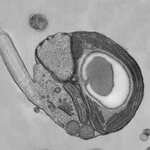Science category landing
Medicine

In an Early Edition issue of The Proceedings of the National Academy of Sciences (PNAS) on April 9, 2009, the researchers report that they have been able to determine the molecular structure of a plant photolyase protein that is surprisingly similar to two cryptochrome proteins that control the "master clock" in humans and other mammals. They have also been able to test how structural changes affect the function of these proteins.
"The plant photolyase structure provides a much better model to use to study how the cryptochrome proteins in the human clock function than we have ever had before…

Like a climber scaling a rock face, a migrating cancer cell has to keep a tight grip on the surface but also let go at the right moment to move ahead. Chan et al. reveal that the focal adhesion kinase (FAK) coordinates these processes to permit forward movement. The study will be published online April 13 (www.jcb.org) and will appear in the April 20 print issue of the Journal of Cell Biology.
Crawling cancer cells send out extensions called invadopodia. By releasing enzymes that dissolve the extracellular matrix (ECM), invadopodia clear a path for the cell to wriggle through. As they move,…

Mutations that help HIV hide from the immune system undermine the virus's ability to replicate, show an international team of researchers in the April 13 issue of the Journal of Experimental Medicine. The study was published online on March 23.
When HIV infects a cell, a complex of human immune proteins called HLA (short for human leukocyte antigen) alert killer T cells by displaying bits of the virus on the surface of the cell. The T cells recognize these HIV fragments and mobilize an attack.
Individuals who have certain types of HLA proteins control infection better than others. In people…
VIDEO:
Cells that are identical genetic twins living in the same environments can exhibit dramatically different behaviors.
Click here for more information.
BOSTON, Mass. (April 12, 2009) — In certain respects, cells are less like machines and more like people. True, they have lots of components, but they also have lots of personality. For example, when specific groups of people are studied in aggregate (conservatives, liberals, atheists, evangelicals), they appear to be fairly uniform and predictable…

A team of UCSF researchers has used microRNAs to help turn adult mouse cells back to their embryonic state. These reprogrammed cells are pluripotent, meaning that, like embryonic stem cells, they have the capacity to become any cell type in the body. The findings suggest that scientists will soon be able to replace retroviruses and even genes currently used in laboratory experiments to induce pluripotency in adult cells. This would make potential stem cell-based therapies safer by eliminating the risks posed to humans by these DNA-based methods, including alteration of the genome and risk of…

When cells undergo potentially catastrophic damage, for example as a result of exposure to ionizing radiation, they must make a decision: either to fix the damage or program themselves for death, a process called apoptosis.
It's a stark decision that is as mysterious as it is remarkable, involving what might be described metaphorically as a network of internal alarms that detect damage to DNA packed tightly in the cell nucleus. In intricate ways, cells orchestrate a response to signals from such resident sensors when they are triggered by exposure to radiation or other toxic processes,…

MOSS LANDING, CA — By sequencing the DNA of two tiny marine algae, a team of scientists has opened up a myriad of possibilities for new research in algal physiology, plant biology, and marine ecology. The project was led by Alexandra Worden at the Monterey Bay Aquarium Research Institute (MBARI) and the Joint Genome Institute (JGI). The genome analyses involved a collaborative effort between MBARI, JGI, and an international consortium of scientists from multiple institutions, including University of Washington, Ghent University (Belgium), and Washington University in St. Louis. Initial…

PITTSBURGH—The enchantingly colored seashells that lend beaches their charm could also provide information about how the brain converts memories and sensory information into action, according to research from the University of California at Berkeley and the University of Pittsburgh published online April 7 in the Proceedings of the National Academy of Sciences (PNAS).
G. Bard Ermentrout, a University Professor of Mathematics at Pitt, worked with the paper's lead author, Berkeley graduate student Alistair Boettiger, and Berkeley biophysicist George Oster to model the neural network of…

The DNA in the 23 pairs of chromosomes in each of the billions of cells of the human body is so tightly packed that it would measure six feet in length if stretched end to end. A genome of this size can squeeze into a cell's tiny nucleus because it is compressed into highly condensed chromatin fibers by proteins called histones.
All chromatin in the cell nucleus represents a massive condensation of the genetic material. But a portion of it might well be called super-condensed; it forms a kind of chromatin called heterochromatin. The genes contained within these portions of the genome are…

WALNUT CREEK, Calif.— Scientists from two-dozen research organizations led by the U.S. Department of Energy (DOE) Joint Genome Institute (JGI) and the Monterey Bay Aquarium Research Institute (MBARI) have decoded genomes of two algal strains, highlighting the genes enabling them to capture carbon and maintain its delicate balance in the oceans. These findings, from a team led by Alexandra Z. Worden of MBARI and published in the April 10 edition of the journal Science, will illuminate cellular processes related to algae-derived biofuels being pursued by DOE scientists.
The study sampled two…